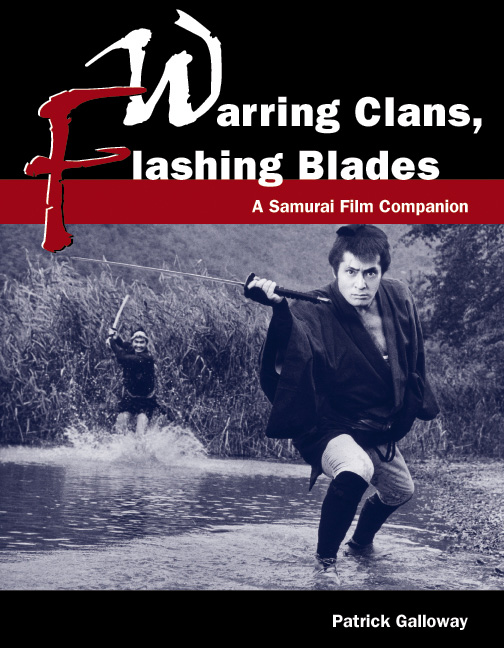
(Stone Bridge Press)
Reviewed by Matthew Caron
Patrick Galloway’s new book Warring Clans, Flashing Blades: A Samurai Film Companion is a neatly arranged tome devoted to the cult of the Japanese swordplay flick well worth checking out for anyone with a passing interest in these films. That it has been designated a so-called companion is right on the money. While it contains all the research and careful thought befitting an academic text, Warring Clans is the work of a fan trying to pass along his passions to whoever might be interested. Not quite a guide and not comprehensive enough to constitute a full survey, what we have here is a list of favorites supported by a wealth of enthusiastic explanation and criticism. Galloway’s purpose is to get you to take a chance on what he considers to be fifty really cool films. He is a charming obsessive who wants you to nerd out with him.
Warring Clans, Flashing Blades opens with an examination of the samurai both as a historical figure and the subject of drama and visual art for the course of centuries. The hero of a Samurai film, formally known as the makato no bushi, is typically a loner, only very rarely a leader and is usually destined for a bad end when his ideals inevitably clash with authority and power. Galloway helpfully pinpoints the special appeal of the samurai by introducing readers to the Japanese concept of hoganbiiki.
“Over the centuries, hoganbiiki has come to mean “sympathy for the loser,” and points to a sophistication (some might say cynicism) in the political understanding of the Japanese people, namely that no good deed goes unpunished, that the good die young in this wicked world, frequently from a self-inflicted belly cut, and well, hurray for them! The man of makato follows his heart, while the pragmatist weighs his options; the makato no bushi is informed by his ideals, the pragmatist by logic, influence and advantage; the hero, for all his passion and righteous cause, is doomed. The pragmatist prevails and rules.”
The samurai represents principle and passion pitted against the agents of a corrupt and cynical world, and so the samurai remains fresh and open to new interpretations increasingly divorced from his historical roots. There’s no mention of any samurai-in-space pictures in this book, but there’s no reason it couldn’t be done.
However, Galloway’s insistence on presenting the Japanese warrior as a historical character means that Warring Clans, Flashing Blades is arranged according to the eras in Japan’s history. This approach to organization should be a boon to anyone approaching these films from a background in Japanese history, but to relatively ignorant gaijin like myself who are just in it for the movies, it’s not a hindrance. Within this historical framework, Warring Clans covers the gamut from Sadao Yamanaka’s 1935 landmark The Million Ryo Pot on through modern revisionist works like Takashi Miike’s Izo which concerns itself with the soul of an executed samurai traveling through time, mixing himself up in the events of World War II and transforming into a demon. Galloway isn’t a purist, and his enthusiasm for inspired schlock like G.I. Samurai and pinky exploitation fare like Quick-Draw Okatsu is on par with his admiration for the Shakespearean gravitas of Akira Kurosawa’s epics. Whatever your taste in genre, Galloway can produce a fine example of the form concerning the exploits of a put-upon swordsman (or woman). The book also does a fine service by including films that are currently unavailable on DVD in the hopes of inspiring publishers to release them, and in the case of Zatoichi’s Pilgrimage takes Criterion to task for failing to release an allegedly stunning property they’ve been sitting on far too long.
Where convoluted plots or obscure cultural references might prove a hindrance to cinematic bliss, Galloway rushes to the reader’s aid with helpful diagrams and sidebars offering cultural enlightenment from Takuan, The Know-It-All Priest. Takuan, a helpful if somewhat crusty wandering sage, has been grudgingly conscripted into the service of explaining details likes why certain swordsmen appear to be wearing wicker baskets over their heads. I like Takuan very much and would not be opposed to the idea of Takuan getting his own book or TV series, in which he explains the vagaries of ancient Japan to those of us who have experienced it primarily through modern pop culture.
.
Galloway also devotes introductory chapters in each era to a limited and somewhat imperfect set of profiles devoted to the major performers and filmmakers of the jidai geki format. I say limited and imperfect because it fails to include profiles of directors and performers that Galloway returns to repeatedly over the course of the book. While this exclusion makes sense for some repeat offenders such as Toshiru Mifune and Tatsuya Nadakai – frequent stars of Akira Kurosawa’s swordplay epics with a substantial literature on offer elsewhere – others seem slighted. Galloway covers several films by Hideo Gosha and even suggests that his Goyokin might be the ultimate Samurai flick, but somehow neglects to give him a standalone profile. A proper biographic sketch of Shintaro Katsu, star of the immensely popular Zatoichi films represented by four separate entries in this book, would also have been appreciated. Still, these complaints feel ungenerous in face of the wealth of information and enthusiasm on display here. Warring Clans, Flashing Blades succeeded in getting me to rent and watch Goyokin and I loved it. Hideo Gosha has a new fan and my Netflix queue is now saturated with Galloway’s recommendations.

No comments
My first book, Stay Dogs & Lone Wolves, features bios of Mifune, Katsu and the rest — didn't want to repeat myself here.
Thanks for the kind words.
PG